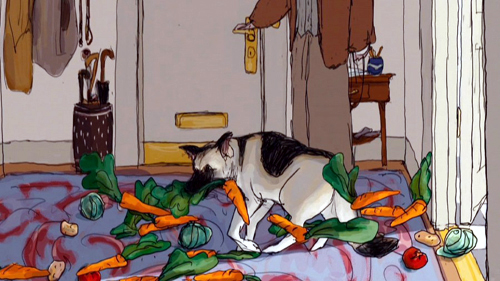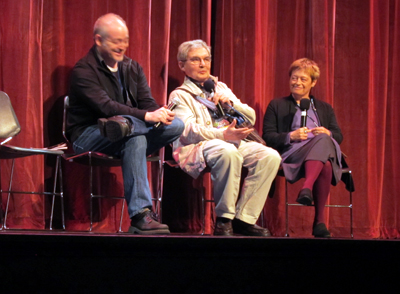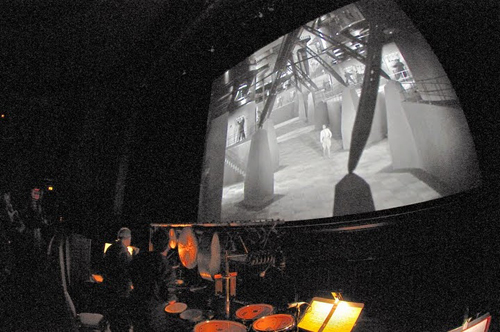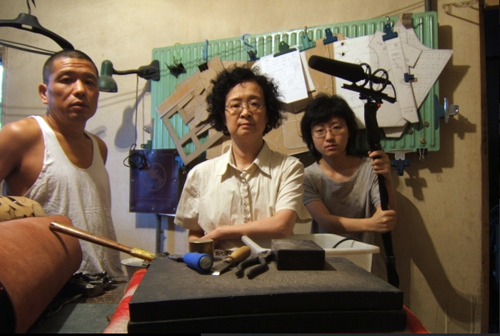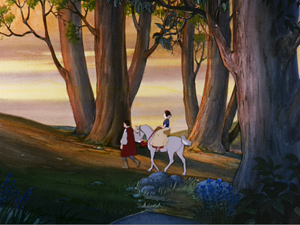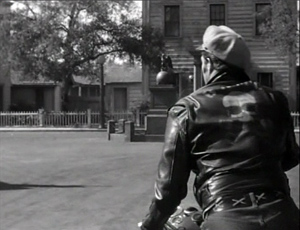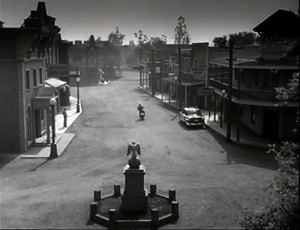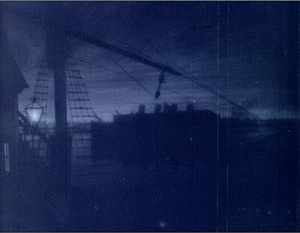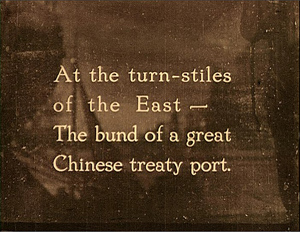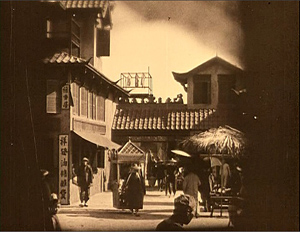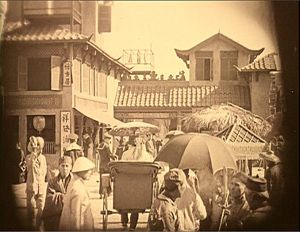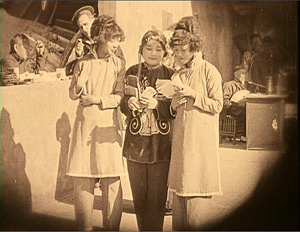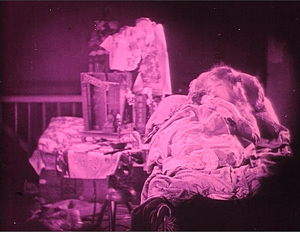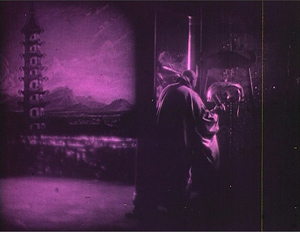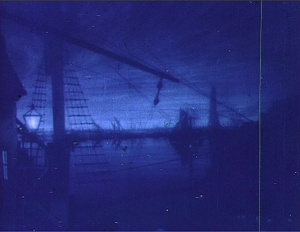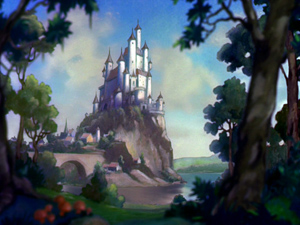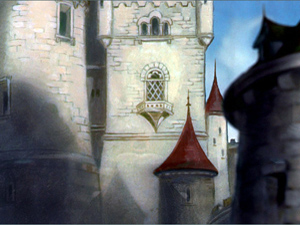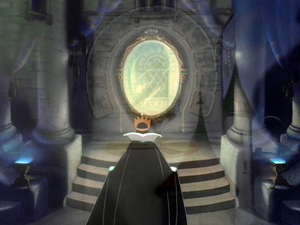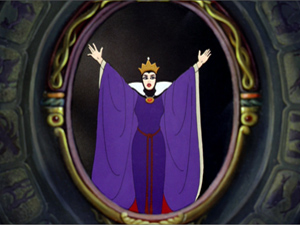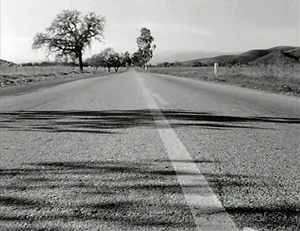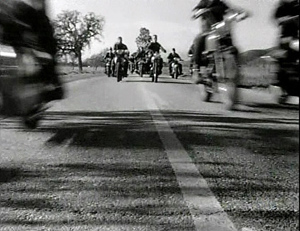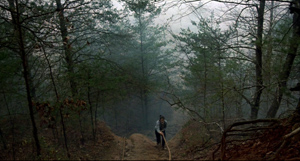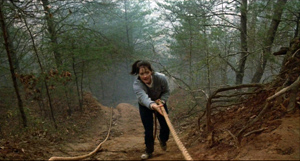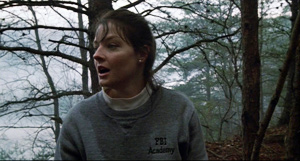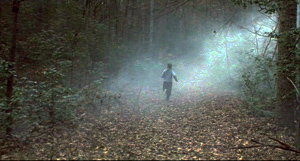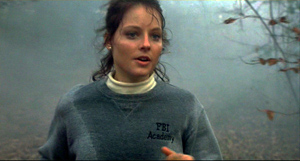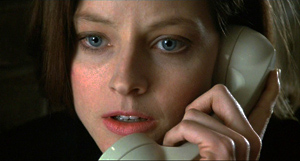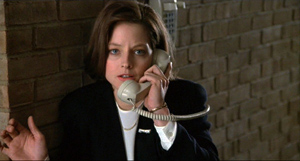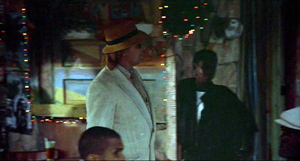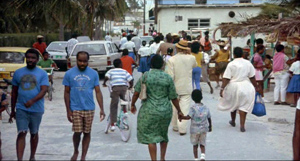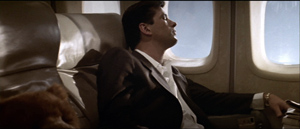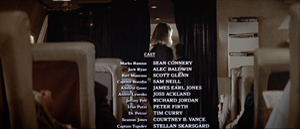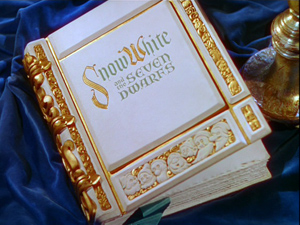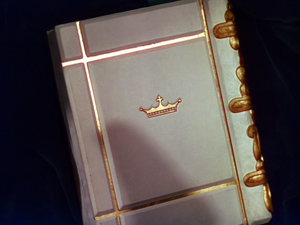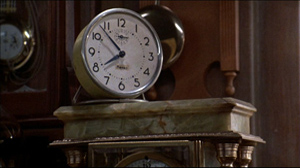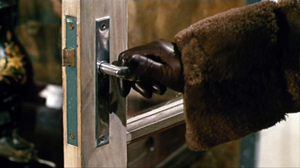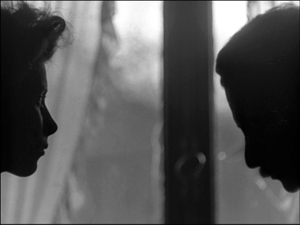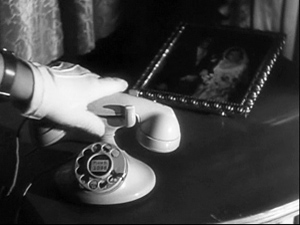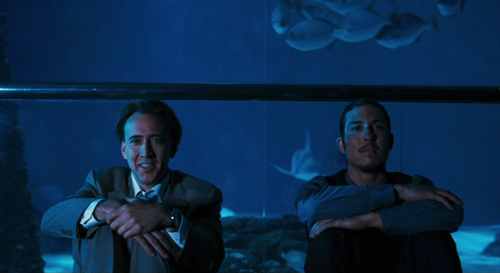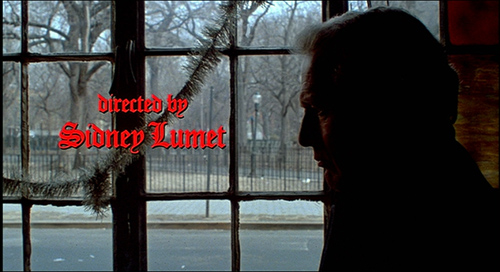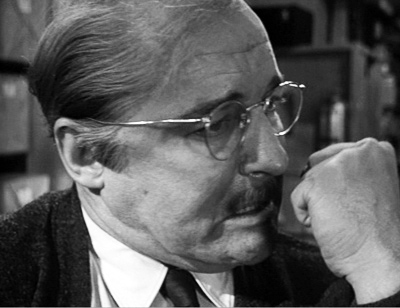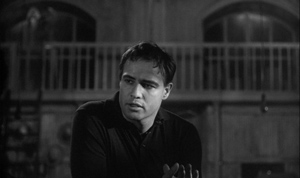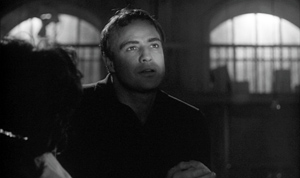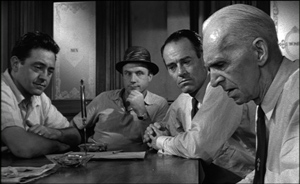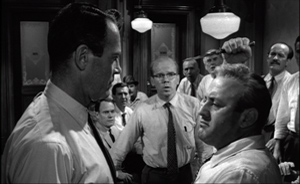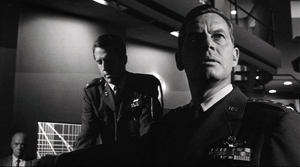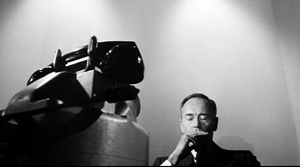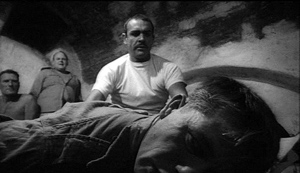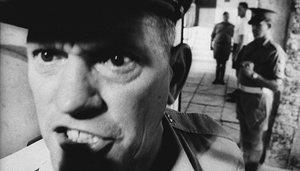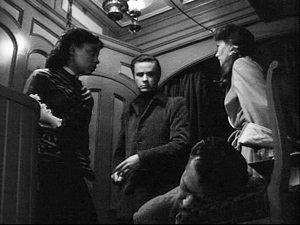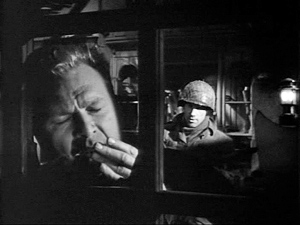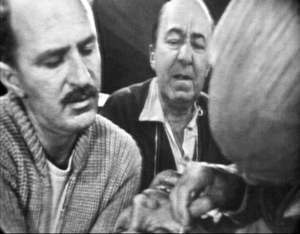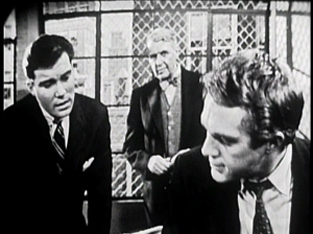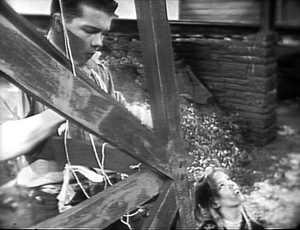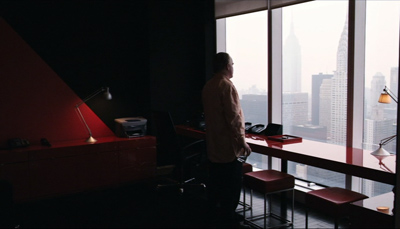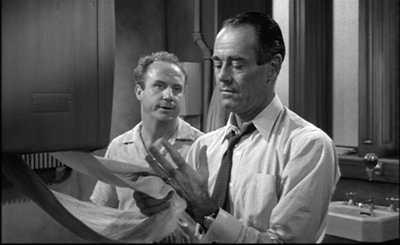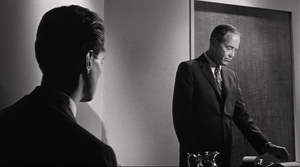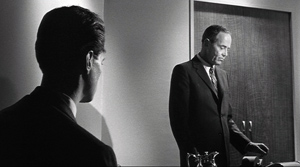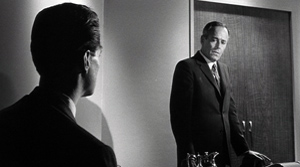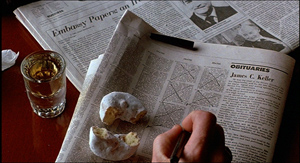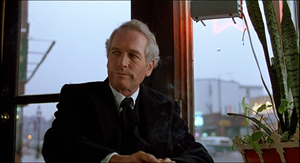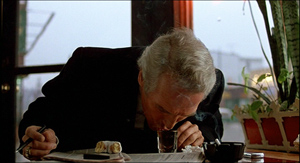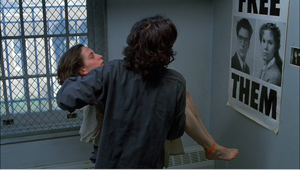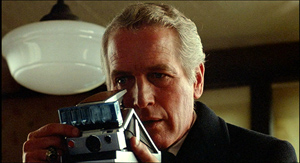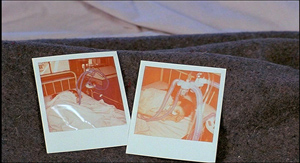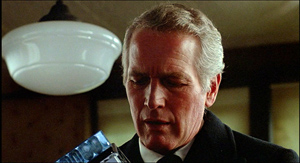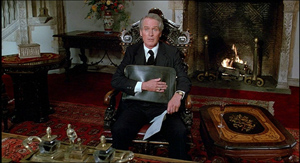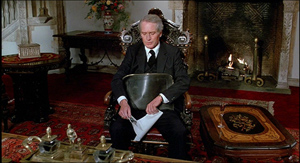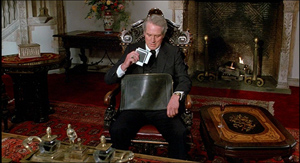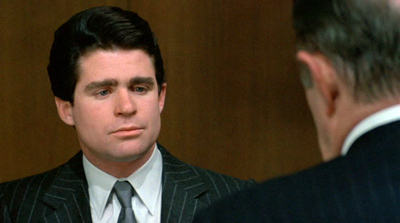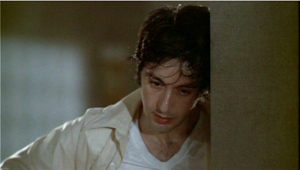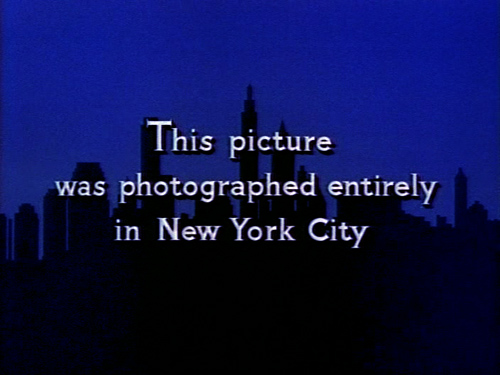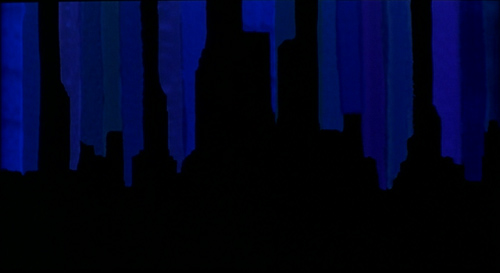Archive for April 2011
An all-too-short visit to Ebertfest 13
Tulip’s unique way of expressing delight at the prospect of walkies.
Kristin here–
With David still recovering from pneumonia, I drove down to Champaign-Urbana by myself for a truncated Ebertfest visit. As always, 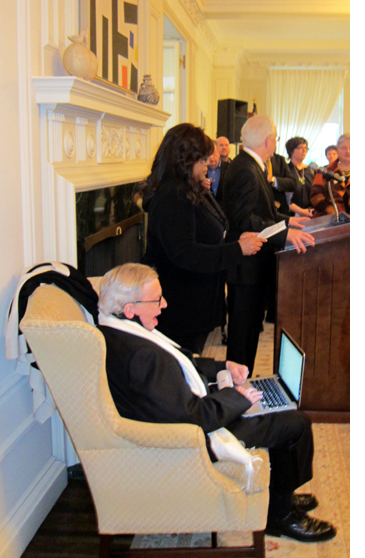 the event began with a reception at the president’s home, where Roger delivered a speech via his talking computer (left).
the event began with a reception at the president’s home, where Roger delivered a speech via his talking computer (left).
This year, rather than kicking off the festival with a Wednesday-night screening of a 70mm print, the opening program was a screening of the restored version of Metropolis, incorporating footage found in Argentina. (David has already blogged about the new version, having seen it last year at the Hong Kong Film Festival.) I had the privilege of introducing the screening.
Roger’s program notes gave a good summary of the film and its latest restoration, so I talked a little about why it’s not all the odd that a nearly complete print should be found in Argentina. First there’s the matter of what happened to prints at the end of their theatrical circulation in the silent era. Films didn’t open around the world day and date the way they do now. Prints might be exhibited in one country, then move onto another with new intertitles in a different language cut in. They might be shown for years, until their useful life was over. By that point they might have reached places far away from their place of origin. They were also usually covered with scratches and lines, and they weren’t worth the cost of shipping them back to their makers. They might be buried, as was the case with the 1978 Dawson City find in Alaska, or stored in the attic of a theater, or rescued by a projectionist who tucked them away in a garage. In some cases, collectors acquired them, as happened with the Argentinian Metropolis print. Occasionally these treasures come to light, as recently happened when the Film Archive of New Zealand located several American titles, such as John Ford’s lost silent film Upstream. So far-flung places that long ago were the end of the line for prints are where we might expect them to resurface. Indeed, New Zealand’s archive also held a print of Metropolis that contained some shots not found in earlier restorations or in the Argentinian print, and these appear in this latest version.
A second reason why Argentina is not a surprising place to find a long print of Metropolis has to do with the German film industry’s strength after World War I. Despite having been defeated, the country built up its production until it was second only to Hollywood. European companies found it difficult to sell their films in the U.S.; then, as now, American films dominated their domestic market. German companies sought other areas where they could compete on a more equal footing. They were quite successful in South America, and Fritz Lang’s films were among the most popular there. Small wonder, than, that a well-worn, largely complete print should survive there.
The original score has been reconstructed, but as has become customary at Ebertfest, the Alloy Orchestra supplied their own original accompaniment. (See below.)
Dog-lovers’ delight
The thing that sets Ebertfest apart from other festivals is that it reflects the taste of one person. Roger chooses the films, and his reviews are reprinted in the program as notes. When Roger saw the acclaimed animated film My Dog Tulip, based on J. R. Ackerley’s memoir about life with his Alsatian, he was reminded of another man whose only love was his dog, Umberto D. So, having the ability to program of double feature of the two films, Roger did. Apart from the annual silent film, Ebertfest seldom shows older classics, so this was something of a departure. I had only seen a 16mm copy of Umberto D, way back in my graduate-school days, so it was great to see a 35mm print on the big Virginia Theater screen.
The juxtaposition of the two films worked well, with the grim image of old age and despair of Umberto D followed by the nostalgic but fairly upbeat My Dog Tulip. Judging by the questions and comments afterward, the latter struck a particular chord with dog lovers in the audience, and during the remainder of my stay I heard many pet anecdotes exchanged among people around me.
The film was created by a husband-wife team, with Paul Fierlinger drawing on a digital tablet and Sandra Fierlinger painting in the colors with a computer program. As I pointed out during the panel discussion after Nina Paley’s Sita Sings the Blues was shown at Ebertfest in 2009, computer animation doesn’t mean that the computer does all the work. Far from it. A computer has to have a lot of material fed into it before it can aid in the filmmaking process. Each frame of My Dog Tulip was done by hand, and it has the look of traditional cel animation. (As with traditional cel animation, the Fierlingers use each image twice in a row, so that only twelve drawings suffice for a second of film.) There’s a deliberately rough, slightly jittery look to the outlines of the figures in the shots, helping give that impression of drawn animation.
Ordinarily I would have preferred to see the film in 35mm, but Paul and Sandra told me that the 35mm prints actually washed out some of the vibrancy of the intended colors. The digital print projected at Ebertfest definitely did the colors justice.
Matt Soller Zeitz with Paul and Sandra Fierlinger onstage after the screening
Filling the big screen
On Friday, two very well-known directors presented beautiful, color, widescreen 35mm prints that looked terrific–and huge–on the big screen. (I was sitting in the second row for one, the first row for the other, so the effect was particularly overwhelming.) I had missed Richard Linklater’s most recent release, Me and Orson Welles, in first run, so it was a pleasure to catch up with it. As all the reviewers remarked, Christian McKay uncannily impersonates the real Orson Welles. As Linklater pointed out, McKay was in his  mid-30s at the time of filming, while Welles was a mere 22 during the time depicted–and yet the portrayal works, since Welles didn’t really look young, even at the beginning of his career.
mid-30s at the time of filming, while Welles was a mere 22 during the time depicted–and yet the portrayal works, since Welles didn’t really look young, even at the beginning of his career.
The film pulls a great deal of humor out of rehearsals for Welles’s famous 1937 staging of Julius Caesar, with the director’s whims and ego dominating the proceedings, and Zac Efron’s stagestruck high-school kid providing a naive point of view of the backstage politicking. Given all the antics in the lead-up to the premiere, it’s impressive that Linklater manages to switch gears abruptly and present snippets from the production itself that genuinely suggest the impact of Welles’s revolutionary staging. It wowed New York and pioneered the way for modern-dress versions of the Bard’s works.
The on-stage discussion after the film revealed that the production, which manages to convey 1930s New York so convincingly, was mostly shot on the Isle of Man. The British island not only offered favorable production incentives, but it boasted a well-preserved local playhouse that could double for the long-since-destroyed Mercury Theater.
That evening veteran director Norman Jewison presented one of his less well-known films, Only You (1994). It’s a screwball, absurdly romantic comedy starring Marisa Tomei and Robert Downey Jr., both looking very young and very gorgeous.
After Jewison moved from television into feature films in the 1960s, his early projects included two Doris Day and Rock Hudson comedies (The Thrill of It All and Send Me No Flowers), and he returned to the genre with Moonstruck.
Only You has a slender plot in which the heroine, convinced that a Ouija board has given her the name of the man she will marry, abandons her fiancé to follow a man she thinks is her destined true love across Italy. Cinematography by Sven Nykvist and location shooting in Venice, Rome, and Positano give the film considerable charm.
David has been recovering well, but I didn’t want to leave him alone too long. I returned home today rather than staying through the entire festival. But it was a wonderful few days, and I enjoyed talking with Michael Barker, Paul and Sandra Fierlinger, Kevin Lee, Michael Phillips, David Poland (when he wasn’t busy chasing his lively 15-month-old son), some of Roger’s “Far-flung Correspondents,” and many of the devoted audience members who return year after year to this unique event. With luck, both David and I will be there for the whole event next year.
(From the Ebertfest website)
Note: For a second year, the introductions, post-film discussions, and morning panels were streamed live, and they’re also archived online.
DIY dumplings
DB here in Madison, homebound from pneumonia, pining for Kristin and Ebertfest in Illinois:
The energetic Kevin Lee (when does he sleep?) has prepared a very nice video essay on Liu Jiayin’s Oxhide II at Moving Image Source.
The text is based partly on my blog entry on the movie from 2009. Kevin’s is something of an experimental piece, because it presents extracts from the entry in different voices and languages. I wasn’t able to narrate it because I’ve lost my voice, but the readers did better than I could have. Thanks to Evan Davis and Yuqian Yan, as well as the translators involved.
You can buy Liu’s first two Oxhide films on DVD at dGenerate Films, along with other important recent Chinese titles. Every university film department, and every serious lover of cinema, needs to own these movies. Liu shows what you can do with very few means but a lot of imagination. And Oxhide III is in the works.
And don’t forget to visit the videos of introductions and Q & A’s from this year’s Ebertfest here. Some are streaming, some are archived, all are interesting. As I typed this, Paul Fierlinger was talking about the background to My Dog Tulip.
Molly wanted more
The Crime of M. Lange.
DB here:
I was watching Snow White and the Seven Dwarfs some years ago with a friend’s three-year-old daughter. Molly hadn’t seen the movie before, and she watched it in a fascinated silence. At the end, Snow White and the prince leave the dwarfs and ride off into the distance.
At this point Molly cried, “More!”
This surprised me. How could she know, on her first pass, that the story was ending?
In and out
It has no name that I’m aware of, but it’s one of the most common conventions of movie storytelling. At the end of the film, the story world closes itself off from us. The characters turn away, perhaps walking into the distance. We may get a distant long shot of the scene. In some cases the camera accentuates this withdrawal by craning or tracking away from the action.
At the end of The Wild One, the biker hero smiles at the woman he’s met and goes out into the street. After exchanging a glance with the ineffectual sheriff, he swings his motorcycle around, his back to us. Cut to an extreme long shot as he rides off.
Once you notice this sort of ending, you’re likely to think about beginnings. Sure enough, we find some symmetry. A movie often visually brings us into the story world. Most common is an inward progression, moving from a large view to the central space of action. As far back as 1919, Griffith started Broken Blossoms with an overall view of the harbor and an explanatory title.
Then we have a gradual entry into the Chinese neighborhood, moving steadily from long shots to closer views. The young ladies we encounter aren’t major characters in the plot, but we’re still slowly drawn into the story world.
At the film’s end, Griffith’s cutting will manage a parallel withdrawal, from the lovers to the temple and back to the waterfront view.
In fact, Snow White starts with a comparable, if somewhat smoother shift inward, from the exterior of the Queen’s castle then, via camera movement and dissolves, to the Queen at her mirror.
This last shot reminds us that alternatively, a film can start with the characters coming forward, as if to meet us. This is the way The Wild One begins.
Any sort of combination is possible. The Silence of the Lambs starts with Clarice Starling climbing up a hill toward us and pausing long enough for us to register her as a protagonist.
She then turns and runs off into the forest. If this were an ending, we might see her go off further and further into the distance. But this is an opening, so we follow her with a tracking shot forward, letting her lead us into the story action. Soon we’re back to the frontality and intimacy of an opening passage, like the shot of the Queen.
At the end, Jonathan Demme gives us a pair of “farewell” shots. The first occurs when Clarice, who’s been talking to Dr. Lecter on the phone, hears the line go dead. We pull away from her.
The second farewell shot takes place on Lecter’s end in a Caribbean island. It shows him rising to follow Chilson and walking away from us, to be swallowed up into the crowd.
The Silence of the Lambs takes leave of its protagonists in two alternative ways: If the camera doesn’t move away from our characters, it seems, then the characters move away from the camera. They may even seal themselves off, as when a flight attendant pinches shut the curtain at the end of The Hunt for Red October.
So when we speak of films’ “openings” or “closings,” it seems that we are often talking about a world that initially invites us in but will finally expell us, however slowly and politely.
See it here!
Researchers play Jeopardy! Their answers always take the form of a question. Most film critics work in the declarative mode (“The performances are gripping”), but ideally the academic film researcher works in the interrogative mode. What is this pattern of beginnings and endings doing in movies? How does it work? How did it become common? And how do we learn it?
Take the first question, about the purposes and functions of the device. At one level its neat symmetry mimics the sort of frame that we find in other sorts of narrative, particularly oral storytelling. Fictional stories need to be set off from the surrounding flow of discourse. When we hear “Once upon a time,” we all know a fairy tale is starting. There are equivalents in other oral traditions, as in “Here is a tale . . . .” (Yoruba) and “See it here!” (Hause).
Likewise, oral storytelling traditions use formulaic final lines. In our fairy tales, it’s often “And they lived happily ever after.” Native American folk tales may finish with the storyteller simply saying, “The end” or “Tied up.” African oral epics sometimes use the formula “That is what I know” or “Let us leave the words right here.”
In fact, I cheated a little with my examples from Snow White. The film actually is bracketed by a literal opening and closing.
In film, however, the symmetrical structure is only part of the answer. While a film can copy the literary idea of opening and closing a written text, the medium as a whole offers something more. Thanks to the visual nature of movies, the widening or closing-off of the story world can mimic the act of our entering or backing out of a tangible situation. That’s what we see in Snow White and my other examples. In a sense we greet the characters, and after spending some time with them we bid them farewell. The sense of entering and leaving their world is harder to capture so concretely in literature or theatre.
So we need a more specific account of the convention. Surely you’ve thought about the most obvious candidate. The entry/ leave-taking pattern mimics our activities as perceiving, socially inclined people. For creatures like us, to encounter a new situation or setting simply involves approaching it or letting it approach us, then becoming part of it and fixing our attention on its details. At a party, we amble closer to a knot of people we want to talk with, or someone comes up to us. Sooner or later that encounter ends or trails off, and we withdraw or turn away or watch when others depart. More poignantly, the extreme long-shot option can recall moments when a car or bus or train carried us away from our loved ones. In any case, thanks to moving images the salient features of this very common experience can be made tangible for viewers.
This convention, we might say, is just natural. Molly, who had already logged three years of social experience, could plausibly make the analogy with ease. She recognized that her encounter with the world of Snow White was coming to an end–the characters were leaving her–and could express her regret.
This common-sense answer is, I think, basically right. But it needs to be fortified against some objections.
For one thing, not all films use this convention. Lots of films start with close-ups of particular items in an environment, plunging us into details without a gradual entry (below, Back to the Future; Muriel; ou le temps d’un retour).
And lots of films don’t end with marks of withdrawal or closure. They end on close views, often of the characters or a significant object (below, Le Silence de la mer; Sorry, Wrong Number).
If this pattern were biased by our natural proclivities, wouldn’t it be more common than it is? And if it comes so naturally, why wasn’t it present at the start of cinema, as soon as people started telling stories? Most of the storytelling techniques we now consider very user-friendly, like cutting and camera movement, emerged after many years of moviemaking. It’s akin to a problem in the history of painting: Why did painters need centuries to learn to imitate the way things look?
Moreover, the naturalness can look pretty unnatural. Nobody lies down in the middle of the road to let a horde of bikers sweep by, as in the beginning of The Wild One. The high angle at the end of the movie doesn’t imitate anybody’s likely point of view; it mimics, if anything, a godlike perspective we almost never get. Similarly, the cuts and dissolves that link the views in Broken Blossoms and Snow White don’t have any parallel in our real experience. Tied to our bodies, we can only move toward or away from situations in real time, step by step. The time-compression and freedom of position we get on film are far from natural. In sum, the concrete ways in which this immersion/ withdrawal pattern shows up in actual movies suggest that the films aren’t imitating the literal vantage points we might assume in the real world. There is a lot of contrivance going on.
Real life, amped up
So the convention has some roots in our perceptual and social experience, but filmmakers have streamlined and sharpened it for our uptake. Another example of this process, which I discuss here, involves actors’ eye behavior. Film actors start with normal patterns of looking and blinking, but they modify them in order to signal emotional states and to concentrate our attention on the drama. Similarly, the schema of entering/ leaving a milieu derives from our common experience, but it can be simplified and stylized through cinematic techniques that have no correspondence in our normal experience. All that matters is that the result preserves the core of that schema.
As filmmakers simplify our perceptual and social experiences, they amplify them as well. Movie characters stare at each other more intently than we do in normal life. The actors are stripping off everyday noise (blinks, averted looks) in order to create cleaner, exaggerated signals of mutual attention to the dramatic situation. Likewise, a steep high angle like that ending The Wild One or the pointedly closed curtains of The Hunt for Red October exaggerates the sense of departure and conclusion, giving the action a weight it wouldn’t have in ordinary life.
Why don’t all films use the entry/ retreat convention? I think we should consider such conventions to be tools. They arise in particular filmmaking traditions, perhaps through trial and error, and get refined for different purposes. Some filmmakers might never use them, or knowingly refuse them to create different reactions, or play games with them (as Resnais does at the start of Muriel). But when filmmakers want certain effects, these tools are ready to hand. If you want to ease your audience into the story world, a slow entry pattern works very well. It’s so familiar that the viewer can overlook its contrivance and concentrate on the story information.
So Jeopardy!-style, we have new questions. Has the opening/ closing device spread because it is a very accessible, spontaneously understood convention? Or is it because filmmakers in other cultures have mechanically copied Hollywood? Perhaps it’s like a tool that originates in particular cultural circumstances but which can be useful all over the world. The Phillips-head screw was devised for the US automotive industry but is now a universal gadget. Over time, such tools become more widespread, perhaps dominant. But a tool can always be refused if the task changes.
There’s still a mystery, though. Assuming that viewers understand these image-clusters as signaling beginnings and endings, how did that understanding come about? How, and when, do people learn the conventions? If they are quickly learned, is that because they play into inclinations of our minds?
My best guess for now is this. We tend to think that all artistic conventions are equally hard to learn, but that’s probably not the case. The conventions of Cubist painting demand more effort and knowledge than the conventions of perspective drawing, and that’s probably not just because we’ve seen more perspective pictures across our lives. Likewise, mastering the conventions of Structural Film demands more time and trouble than mastering those of popular genre filmmaking. It seems likely that some conventions rise to dominance because they fit most viewers’ prior inclinations rather well. For example, we are creatures who interact socially in face-to-face manner. Shot/ reverse-shot editing is unfaithful to our ordinary experience in many ways; cuts provide instant changes of viewpoint we can’t achieve in real time and space. But shot/ reverse-shot cutting preserves the familiar social pattern of turn-taking and conversational flow, so it’s comparatively easy to learn.
Still, I don’t have a full answer. My questions bring us back to Molly. If she had seen Snow White before, we might say that she remembered that the film ended at this point. But she hadn’t seen the film before. So does her demand for more indicate that she generalized from her experience of other films? Did she have already a degree of “narrative competence,” allowing her to recognize certain types of cues? Is her competence full or spotty? (Maybe she gets endings, but not characters’ intentions, or goal orientation.) And how did she acquire that competence? Quickly or slowly?
Maybe some researchers have already explored how children master narrative framing of this sort. (I’d welcome correspondence on the matter.) My hunch is that Molly grasped the cinematic convention, perhaps on limited exposure, because she recognized the core perceptual and social experiences it preserves. Leveraging this insight, perhaps, was some understanding of narrative architecture generally. More basically, it may be that as social animals we’re tuned by evolution to detect fairly quickly some constant features of interactions with our peers.
In any case, I’m betting that Molly wasn’t simply mastering a convention cut off from everyday life, like algebraic equations. To learn anything, you already need to know a lot. Cinematic storytelling isn’t, as some semiologists once thought, a highly arbitrary sign system. It piggybacks on our experience of the world–our knowledge, certainly, but also our most routine ways of sensing and thinking. Not least, understanding movies taps skills associated with our social intelligence. More on this in a future entry, I hope.
This is only an anecdote, but I hope it provokes readers to think about the broader issues I raise. I floated these ideas in my closing address for the convention of the Society for Cognitive Studies of the Moving Image, on 5 June 2010. I thank the members of the audience for their contributions to that discussion. Incidentally, this year’s meeting is coming up, in Budapest this June. For more on SCSMI and the sort of issues broached in this entry, go to this category on this site.
My basic argument for a “moderate constructivism” in understanding film conventions is developed in the 1996 essay “Convention, Construction, and Cinematic Vision,” reprinted in Poetics of Cinema (2008), 57-82. I discuss the entry/ withdrawal pattern as a holistic strategy in a later essay in that collection, “Three Dimensions of Film Narrative”, 94-95. An earlier, more fancily titled piece puts the pattern in the context of a different argument: “Neo-Structuralist Narratology and the Functions of Filmic Storytelling” in Marie-Laure Ryan, ed., Narrative across Media: The Languages of Storytelling (2004), 209.
It’s worth mentioning that, like Snow White, the images at the start and conclusion of Le Silence de la mer are enframed by a book–in this case, shots of the original book by Vercors. This iconography is of course common when a film wants to emphasize the literary origins, though in some films, like Dreyer’s, the device of the film as a replay of an already-written text plays a more complicated narrative role. I talk about that in my book The Films of Carl Theodor Dreyer (1981).
The research on children’s understanding of stories is vast and detailed. Alison Gopnik briskly summarizes the evidence that even very young children have surprising narrative competence in The Philosophical Baby (2009), chapters 1 and 2. The pioneering source here, at least for an amateur like me, was Katherine Nelson, ed., Narratives from the Crib (1989).
The Bad Lieutenant: Port of Call New Orleans. As in many films, the final shot addresses the viewer in a comparatively overt way.
Endurance: Survival lessons from Lumet
I don’t believe in waiting for the masterpiece. Masterful subject matter comes up only rarely. The point is, there’s something to advance your technique in every movie you do.
DB here:
Across half a century he outpaced his contemporaries. He was the last survivor of the vaunted 1950s generation of East-Coast TV-trained directors, men who went over to theatrical films just as the studio system was in decline. John Frankenheimer, Martin Ritt, Richard Lester, and Franklin J. Schaffner won big projects early on, but they also faded faster. As they were moving out of the game in the 1970s and 1980s, Lumet was getting his second wind. He ground movies out–good, so-so, or wretched–like a contract director of the studio days. Sometimes he had a strong stretch, as in the early 1980s, and sometimes not. He started in his early thirties with Jean Vigo’s cameraman Boris Kaufman, shooting crystalline black and white. At the end he was making a feature in high-definition video.
When Lumet died on 9 April, journalists were generous in their praise. But most of the eulogies seemed to me constraining. They overlooked his complicated role in postwar American film, and they neglected to supply the sort of historical context that make even his negligible films of interest. Concentrating on his official masterpieces (Dog Day Afternoon, Network), the obituaries cast him as a hard-nosed urban realist. That’s part of the story, but if we want a fuller picture of this long-distance runner, we need to trace his path in more detail. That in turn can teach us something about shifting generational opportunities in American cinema.
We can start by noting what the recent accolades seem to have forgotten: at the start of his career Lumet faced brutal hostility from the critical intelligentsia that ruled his home town.
Danger man
The Pawnbroker.
Reading 1960s film criticism, you might think that Sidney Lumet was the biggest threat to film art since the Hays Code. Young cinephiles today may be unaware of the vituperation that New York’s highbrow critics showered on him at the start of his career.
John Simon: “What is Lumet good at? Intentions, underlining, and casting.”
Manny Farber: “Giganticism is, of course, the main Lumet contribution [to The Group]. . . . Miss [Shirley] Knight, in a concentrated post-coitus scene atop [Hal] Holbrook’s chest, has a head the size of a watermelon.”
Andrew Sarris: “The Pawnbroker is a pretentious parable that manages to shrivel into drivel.”
Most tireless was Pauline Kael, who throughout the decades picked off nearly every Lumet movie with the casual contempt of Annie Oakley shooting skeet. From the backhanded compliment (“The Pawnbroker is a terrible movie and yet I’m glad I saw it”) to the eviscerating dismissal (Deathtrap is “an ugly play and what appears to be a vile vision of life”), Kael did not relent. She found Lumet’s staging “slovenly,” his color schemes inept; in Serpico “scene after ragged scene cried out for retakes.”
The hunt was in full cry in Kael’s 1968 essay, “The Making of The Group,” one of those behind-the-scenes journalistic forays that always end in tears for the production. Every such think-piece mysteriously assures the film’s commercial failure, while guaranteeing that posterity will remember each participant as a knave or a fool. Yet for sheer bloodthirstiness, Kael’s reportage easily surpasses that of her predecessor Lillian Ross in Picture.
Kael is out to show that the conditions of acquiring, producing, and marketing films have become almost utterly corrupt. No artist can survive the system. So she starts by establishing Lumet as merely a journeyman, shooting the script as a straightforward job of work.
But then things get rough. He is, for one thing, a poor craftsman.
He cannot use crowds or details to convey the illusion of life. His backgrounds are always just an empty space; he doesn’t even know how to make the principals stand out of a crowd . . . . Lumet is prodigal with bad ideas . . . . He will take the easiest way to get a powerful effect; in some conventional, terribly obvious way he will be “daring” . . . The emphasis on immediate results may explain the almost total absence of nuance, subtlety, and even rhythmic and structural development in his work. . . . I was torn between detesting his fundamental tastelessness and opportunism and recognizing that at some level it all works. . . . Because Lumet can believe in coarse effects he can bring them off.
He is also a severely deficient human specimen.
[He was] the driving little guy who talked himself into jobs . . . He seems to have no intellectual curiosity of a more generalized or objective nature . . . For Lumet, a woman shouldn’t have any problems a real man can’t take care of . . . . He’ll go on faking it, I think, using the abilities he has to cover up what he doesn’t know.
Kael has her generous moments, praising Long Day’s Journey into Night (1962), chiefly because of the performers, and in later years she would admire scenes in Dog Day Afternoon (1975). But usually her admiration boomerangs into a complaint (Lumet yields a fast pace, but that makes him slapdash). On the whole she and her Manhattan peers, who seldom agreed on anything, conceived Lumet as dangerous.
Why? Partly because they mostly set themselves against the middlebrow culture of the newspapers and newsweeklies. Many of Lumet’s early films were admired by staid critics. Praise from these quarters was anathema to the sophisticates. Somebody had to tell the Times’ Bosley Crowther that The Pawnbroker (1965) was not “a powerful and stinging exposition of the need for man to continue his commitment to society.”
Another strike against Lumet was his pedigree. He was said to have brought TV technique, simultaneously bland and aggressive, to theatrical cinema. Early live TV drama, confined by the home screen’s 21-inch format and weak resolution and hamstrung by punishing shooting schedules, pushed directors to rely on flatly staged mid-range shots, goosed up with close-ups, fast cutting, and meaningless camera movements.
Kael suggests that Frankenheimer, a common foil to Lumet at the period, managed in films like The Manchurian Candidate (1962) to convert the TV look into “a new kind of movie style,” though she never explains what that consists of. By contrast, Lumet simply followed the line of least resistance, emptying out his shots and “hammering some simple points home.”
There’s nothing on the screen for your eye to linger on, no distance, no action in the background, no sense of life or landscape mingling with the foreground action. It’s all there in the foreground, put there for you to grasp at once.
The TV style threatened to suffocate the glories of cinema: the full view, a more leisurely unfolding of action, a sense of life flickering on the edges of the plot. For Kael the TV-trained Lumet exemplifies the loss of the great tradition of artistic moviemaking personified in Jean Renoir.
Lumet was dangerous in another way. He seemed part of a trend toward heavy-handed showoffishness. Partly the trend was seen in the sweaty strain of Method acting, typified in Kazan’s work. Manny Farber proposed that the Method was at the center of the “New York film,” a fake realist package predicated on psychodrama, arty compositions, and liberal pieties. 12 Angry Men was “counterfeit moviemaking,” filled with “schmaltzy anger and soft-center ‘liberalism.’” Hard-sell cinema, Farber called it. Dwight Macdonald saw the same bludgeoning in The Fugitive Kind.
Lumet’s direction is meaninglessly over-intense; lights and shadow play over the close-up faces underlining lines that are themselves in bold capitals; every situation is given end-of-the-world treatment.
The new tendency toward self-conscious artifice didn’t just have New York roots. The French New Wave’s somewhat disjunctive cutting, unexpected camera movements, freeze-frames, and other flagrant techniques made audiences and filmmakers aware of film style to a new degree. Tony Richardson, John Schlesinger, and other directors scavenged these devices to give their films an up-to-date panache. Once more a critic needed to invent a new label for Lumet: Macdonald claimed that he was an exponent of the Bad Good Movie, “the movie that is directed up to the hilt, avant-garde wise,” in the vein of Mickey One, The Servant, The Trial, and the work of Godard. The Pawnbroker’s fragmentary flashbacks led Sarris to call it Harlem mon amour.
Harsh as they are, these comments do have a point. The early films shout and scream a lot, both dramatically and pictorially. Lumet admitted his love of melodrama, conceiving it not simply as overplaying but rather as conflict at the highest pitch of arousal: extreme personalities in extreme situations. So a silence is usually prelude to an outburst, and a bellow or a slap is never far off. The jury deliberations in 12 Angry Men (1957) become a group therapy session (or an Actors Studio class?) in which bigots must confess their traumas.
Stage Struck (1958) and The Group (1966) are pictorially innocuous, perhaps partly because they were shot in color, but The Fugitive Kind (1960) is a banquet of elaborate lighting effects whipped up by Kaufman. Macdonald wasn’t fair in his dismissal; the film is dominated by medium and long shots, with close-ups held in reserve for big moments, and the line readings don’t seem to me as overbearing as he suggests. Still, there is a sense of pressure, with very precise reframings and sets densely packed (mirrors, curtains, staircase railings) in a way that accords well with Williams’ overripe dialogue. There is an upside-down shot, and at some moments, as Macdonald notes, the illumination lifts or drops in magical ways—a surprise gift, Lumet claims, from Kaufman.
As a pluralist, Lumet would stage some scenes in full shots and long takes, sometimes at a surprising distance from the camera. But it was hard not to notice the other extreme. His most famous black-and-white films mixed in tight close-ups, oppressive sets, wide-angle distortions, and chiaroscuro. 12 Angry Men is relatively subdued in this regard, building toward more looming images at the climax, with some powerfully jammed ensemble frames.
Fail-Safe (1964) surrenders itself to flamboyant shot design once we get into the war room and then into the President’s sealed chamber. Contra Kael, as in 12 Angry Men, many of these shots have busy backgrounds, albeit not of the Renoirian sort.
The Pawnbroker (1965) is Lumet’s most famous orgy of strident technique, with Sol Nazerman nearly as caged at his counter window as he was in the camps. Even more overwrought is The Hill (1965) in which short lenses pump officers’ raging faces into gargoyle shapes, with pores and welts and gobs of sweat thrust under our noses.
In sum, this is not the director eulogized in Entertainment Weekly: “He never tried to dazzle audiences with flash and style.”
What critics didn’t note, however, was that the more outré look cultivated by Lumet, Frankenheimer, Ritt, and company fitted fairly snugly into 1950s Hollywood black-and-white dramatic style. The blaring deep-focus and violent close-ups exploited by the TV-born directors were already visible in the work of Mann (The Tall Target, 1951, below), Aldrich (Attack! 1956, below), Fuller, and many other directors.
During the 1950s what we might call roughly the “post-Welles” look was well-established for serious subjects and genre pictures alike. The Hill pushes things a bit, as Frankenheimer did in Seconds (1966), but the cramped, low-angle style on display in Lumet’s early work is part of a tradition that goes back years (and which had its echoes in many overseas directors, such as Bergman and Fellini). The wilder reaches of that style, it now seems clear, belonged to Fuller and company, not to mention the Kubrick of Strangelove and the Welles of Touch of Evil. Like Richardson, Schlesinger, and others, the TV émigrés may have gotten their wrists slapped for trying to map onto prestigious social-message movies the visual pyrotechnics already acceptable for program pictures.
Not incidentally, some directors had already found the wide-angle deep-focus look useful in their TV productions. Below are frames from Requiem for a Heavyweight (directed by Ralph Nelson, Playhouse 90, 1956); The Defender (directed by Robert Mulligan, Westinghouse Studio One, 1957); and Lumet’s own omnibus program Three Plays by Tennessee Williams (Kraft Television Theatre, 1958).
You can argue that their move to cinema actually smoothed out the directors’ style. The less square frame and bigger scale of the theatre screen made films like Frankenheimer’s debut The Young Stranger (1957) more spacious and relaxed than what could be seen on the box. 12 Angry Men was a polished effort, starting with an elaborately staged six-minute crane shot assembling the cast in the jury room, and using the width of the screen to enclose several faces. Looking back, we can see that Lumet offered something quite close to then-current Hollywood norms, and it looked less crude than what would be found on live TV of the period.
Still, The Pawnbroker and other films can be credited (or blamed) with helping spread the in-your-face style that would come to dominate American cinema of the next fifty years: disjunctive editing, slow motion, the arcing tracking shot (The Group), handheld shooting for moments of violence or anguish, glum color schemes (preflashing for The Deadly Affair), the teasing flashbacks that will be gradually filled in. Lumet’s early films are anthologies of most of today’s tics and tricks.
Yet by the time of his death, the director who was once feared as the vanguard of something new and awful had come to embody something old and trustworthy. Somehow the unambitious journeyman and pretentious copycat became a “classicist.”
How did that happen?
A prince of the city
Before the Devil Know You’re Dead.
Instead of indicating that he was joining or extending a tradition, Lumet reacted to the hailstorm of criticisms with surprising equanimity, at least in the interviews he gave so abundantly throughout his career. He was modest, acknowledging that many of his films turned out to be feeble, and he declared himself a learner. He tried different projects, he said, to improve himself. He wanted to learn to manage color, to work in different genres (e.g., the dark comedy Bye Bye Braverman, 1968), eventually to fall in love with digital video capture. To some extent Lumet changed because he really wanted to learn more and explore various sides of moviemaking.
Lumet always claimed that he didn’t apply a personal style to his projects; he tried to find the best way to handle the script. He thereby confessed himself to be what auteur critics of the 1960s were calling a “metteur-en-scène,” the director who judiciously enhances the material rather than transforming it to suit his personality. This was probably a good survival strategy in the new churn of the 1970s.
The mid-1970s was the Great Barrier Reef of American cinema. Virtually no members of Hollywood’s accumulated older generations, from Hitchcock and Hawks through the 1940s debutantes (Wilder, Dmytryk, Fuller, Siegel) and the 1950s tough guys (Aldrich, Brooks) to the TV émigrés, made it through to 1980. Many careers just petered out. The future belonged to the youngsters, the so-called Movie Brats. In this unfriendly milieu, Lumet fared better than most. He tried a semifarcical heist film (The Anderson Tapes, 1971) that mocked the rise of the surveillance society, with everybody wiretapping and taping and videoing everybody else. He mounted a classic mystery (Murder on the Orient Express, 1974), a musical (The Wiz, 1978), and a free-love romance (Lovin’ Molly, 1974). Of the items I’ve seen from these years, the most daring is The Offence (1972). This study of a sadistic British police inspector’s vendetta against a child molester offers a sort of seedy expressionism. In another gesture toward psychodrama, long conversations with the perpetrator reveal that the copper is a bit of a perv himself.
Lumet’s most successful rebranding took place in a sidelong return to the Pawnbroker milieu: low-end, location-shot, crime-tinged social commentary using New York theatre talent. Filming in color and casting off the baroque precision of the earlier work, he made his compositions more casual and his shot changes less precise. His cutting pace picked up: six seconds on average for Serpico (1973), five for Dog Day Afternoon (1975), both courtesy of the high priestess of the quick cut, Dede Allen. The driving tempo of these movies gave them an urgency that critics could tie to the ticking-clock plots, the atmosphere of urban pressure, and of course the extroverted acting of Al Pacino.
With the two crime films, and the satiric Chayefsky talkfest Network, Lumet remade his image. He was a New York filmmaker, offering raucous, hard-nosed, semi-cynical takes on corruption in the police, the justice system, politics, and the media. His protagonists tended to be Jews, Italians, and Irish, all working stiffs or bare-knuckle power brokers; and the enemy, again and again, turned out to be the Ivy elite. A tailor-suited WASP, male or female, was likely to sell you out. Only ethnic minorities knew the real score. The line could come from almost any mid-career Lumet film: “I know the law. The law doesn’t know the streets.”
The crowning achievement in this vein, for critics if not for audiences, was Prince of the City, a sprawling study of a cop’s patient years of taping and informing on his corrupt colleagues. More slowly paced than the earlier urban dramas, the film also marked Lumet’s move toward something else again. The style was drier and more sober, almost passive, emphasizing static and somewhat distant setups; the cutting slowed down to nearly nine seconds on average. As mid-period Lumet had blotted out the early years, now something more calm, even comparatively austere, came into view.
Whatever the project, however, by the later 1980s he was offering his own alternative to the fast-cut, whirlicam style that was bewitching young filmmakers. While directors in all genres were building scenes out of endless choker close-ups and cutting every four or five seconds, Lumet applied the brakes, lingering on two-shots, letting whole scenes play out in full frame, moving his actors around and ordaining a cutting pace close to ten seconds on average. The first eight minutes of The Verdict (1982) consist almost entirely of long shots and extreme long shots. The protracted takes and antic bodily contortions of Deathtrap might have come from a French boulevard farce; the first tight single of Christopher Reeves is delayed for half an hour. In an age in which critics decried the choppy confusion of tentpole action, the plainness on display in movies like Running on Empty (1988) and Night Falls on Manhattan (1997) looked anachronistic. Right to the end, Before the Devil Knows You’re Dead (2007) could spare a lengthy and distant shot to register a high-end drug boutique and shooting gallery. We had come from the Hysterical Lumet by way of the Gritty Lumet to the Restrained Lumet.
Acting in the frame
Yet he did not milk the urban crime vein dry. He continued to try a wide range of projects, even probing the Red Scare in Daniel (1983). The rationale was chiefly performance. Lumet was an “actor’s director.” He demanded at least two weeks of rehearsals, which included not only table readings but eventually full blocking of scenes, including fights and chases. Derived from his TV and theatre days, the method suited his belief that actors needed a firm structure in order to invent their characters. Interestingly, this actors-first rationale can be adjusted to any phase of the rough stylistic development I’ve plotted. The high-pressure facial shots of the early films can highlight the minutiae of the performances. But so can mid-shots that let actors build in bits of business.
Manny Farber praised the moment when Fonda in 12 Angry Men dries his fingers at length, one by one. It shows, Farber says, “the jury’s one sensitive, thoughtful figure to be unusually prissy” and provides a “mild debunking of the hero.” But it’s not the unintegrated detail Farber claims; Fonda’s coldness is set up early in the film, when he stands remotely from his peers and shows no interest in them as men. And Fonda was always a master of finger-work, which Lumet could exploit in fastidious framings. In Fail-Safe as the President tries to halt the bombers rushing toward the USSR, Fonda projects the man’s minutely controlled apprehensions by pausing to rub his fingertips together, off in the corner of the shot.
This micro-gesture suddenly leaps, as Eisenstein might say, into a new quality: a worried facial expression.
More explicit is the characterizing moment in The Verdict when Frank Galvin (Paul Newman) starts his day with a sugar donut and a full glass of whiskey. The setup is concise: He has crossed off the wakes he’s visited, and his palsied hand can’t pick up the glass without spilling some.
So Frank checks to see if anyone is looking before, like a dog, he bends his head to slurp off a little.
It’s a simple but powerful image of degradation, far removed from the trembling mouth and bulging brows of Steiger in The Pawnbroker.
Lumet cared as much for camera technique as for acting maneuvers. His book Making Movies provides a virtual manual of movie style as draftboard engineering. His gearhead side was probably another legacy of the buccaneering days of live TV and the New-Wave inspired awareness of artifice. He took inordinate pride in his “lens plots” and lighting arcs, charting purely technical changes that would weave their way through the film. (In this he was ahead of his time; now most filmmakers develop these technique arcs, or at least they say they do.) Despite this almost mechanical conception of technique, though, late Lumet rediscovered a bare-bones simplicity of performance and framing that was willing to risk looking flat. In Daniel, he lets the angry young man whose sister has wasted away into madness confront the poster agitating for their dead parents. No tracking in, no circumnambulating camera, no heightened cuts or nudging score. And no need to see Daniel’s face. Susan merely lifts her head.
It’s as if the visual rodomontade of the Movie Brats drove Lumet toward a new sobriety. When Galvin is preparing to try the case of the girl left in a coma through medical malpractice, he visits the hospital and takes Polaroids of her inert body. The slowly developing images not only give us the fullest view of the girl we’ve had so far. They also come to suggest his dawning realization that this is more than just a chance for big money.
Galvin starts to grasp that letting the hospital settle out of court will allow the officials to write off their mistake. There is a human cost to simply getting the check. If he does it, he will now be a better-paid ambulance chaser. Yet he doesn’t stand valiant for truth; the drunk is scared, drained of dignity, and he clutches his portfolio as a sad, ineffectual shield.
Offered the money, Frank takes out the photos and weighs them against the check. Then with a sigh of exhaustion, contemplating the fool’s crusade he’s launching, he returns the check and drops the pictures into his bag.
Very simple visual storytelling; it might have come from a 1930s movie. But this stark presentation of moral decision, given as a straightforward framing of a man’s body, achieves a measure of artistic nobility in a year that gave us Porky’s and Rocky III.
Telling it all, holding some back
Prince of the City.
It’s good to remember such moments of pictorial storytelling because Lumet’s films, especially the early ones, tend to be gabfests. If Eugene O’Neill, Tennessee Williams, and Paddy Chayefsky, along with the Method acting tradition, are your coordinates, you will be drawn to chatterboxes and blowhards. Lumet loved the spoken word, which was after all the mainstay of live TV (“illustrated radio,” it was sometimes called). It’s not clear that he ever shook the habit. His characters usually step onstage leaking exposition, announcing their pasts, their personalities, their plans, and their deepest feelings. This has the advantage of making plot premises clear, but it reduces the figures’ mystery and their ability to surprise us, or to complicate our feelings about them.
Sometimes Lumet did let story construction do heavier lifting. It happens in The Pawnbroker, because the nearly catatonic Nazerman speaks so little that the fusillade of flashbacks provides his backstory. More daringly, the large-scale back-and-fill of The Offence, peppered with small memories but also looping around the central incident in the interrogation room, seeks to reveal Sergeant Johnson’s affinities with the suspected child murderer. We need to remember Lumet’s early fondness for time-shifting plots before we declare Before the Devil Knows You’re Dead an old guy’s effort to catch up with Pulp Fiction.
Even without benefit of broken timelines, Lumet could occasionally hold back information to reshape our first impressions. Take the central revelation of Dog Day Afternoon, when cuddly Al Pacino reveals that his “wife” is not the woman he’s married to (a nice plot feint here) but the man whom he loves. This apparently sensationalistic twist comes early enough to modulate into pathos when Pacino’s character dictates his two wills.
Prince of the City realigns our sympathies in a more intricate way. At the start, Danny is presented as a tormented soul. We’re led to think that he turns snitch because of things we see: the invitation to go undercover, his brother’s and father’s angry concern that his pals are crooked, and above all the shameful efforts he makes to get drugs for his informant. Once he turns, however, he can’t limit the investigation, and at nearly the end his treachery has broken the most important ties in his life.
But “nearly the end” is the operative term, because Prince of the City boldly appends a ten-minute epilogue showing Danny being investigated himself. The Danny we saw at the film’s beginning may have been steeped in corruption; the drug bust we saw included, behind the scenes, a major ripoff of money; he has lied more than we realized; and it seems likely that he cheated on his wife with the prostitutes whom he supplied with drugs.
A modern filmmaker, or Lumet in his bodacious early mode, might have spiced these flat testimony scenes with lurid flashbacks. But sticking simply to Danny’s feeble, evasive stonewalling raises questions of his own vulnerability. Having watched him break down over years and having heroicized his suffering to a considerable degree, we have to judge him anew. Is he simply too weary to fight the charges, or has he been caught out? The ending might seem to allow for cynicism, but we can’t cast off our respect for what Danny has risked.
Further, Lumet intercuts the court scenes with government meetings about whether to prosecute Danny. In the manner of a Shavian problem play, this tactic obliges our sympathies to be clear-eyed. If The Verdict lays all its cards on the table and invites straightforward sympathy for Galvin, Prince of the City, by hiding major aspects of Danny’s character and circumstance, leads us to a more nuanced experience. The narrational dynamic of the film invites us to rethink our protagonist’s actions and decide whether to grant him mercy.
In the vanguard of a new style in the 1960s, Lumet remade himself as part of the 70s renaissance. That freed him to cover nearly every bet on the board, and some paid off. As hotshot younger directors sped past him into tentpole territory, he put the independent sector to use–financing through presales, working with stars on the way down and on the way up, releasing the films through boutique distributors, trying many options with a stubborn pragmatism. He handled failure, ignoral, and disdain better than probably any of us could. “Though his films are invariably flawed,” wrote Sarris in 1968, “the very variety of the challenges constitutes a sort of entertainment.” This zigzag career trajectory provides a unique, even heartening EKG of success and survival in the modern American film industry.
At the same time, he helped make audiences and critics more conscious of film technique, in ways both salutary and damaging. He was part of my film school: The very first movie I saw in a theatre during my freshman year of college was The Pawnbroker, and I revisited it several times. Here was a modern instance of “pure cinema,” worth comparing with A Hard Day’s Night and 8 1/2. (Yes, I hadn’t seen much.) Prince of the City has drawn me since I first saw it in a moldy two-screener in Florida and thought: “Can Hollywood have made a Brechtian film?” I leave for another time the tale of watching Prince in a nearly empty screening sponsored by Nick Cave.
You can probably tell that Lumet is not my favorite filmmaker. Several of his movies I earnestly hope never to see again, and even the ones I admire contain moments I would wish otherwise. But he has given me unique pleasures and prodded me to ask some questions that intrigue me. More broadly, I can’t understand the failures and accomplishments of modern American film without taking into account this marathon man.
For this entry, I haven’t managed to see or re-see as much of the Lumet output as I’d hoped, but the twenty-three films I revisited include his most famous titles (except for The Wiz, which might better be called infamous). My comments here supplement those I make about Lumet and his generation in The Way Hollywood Tells It, 145-147.
I’ve drawn my critics’ quotations from anthologies of their writings. The one I should probably signal explicitly is Pauline Kael’s “The Making of The Group,” in Kiss Kiss Bang Bang (Little, Brown, 1968). The piece is dated 1966, but I can’t prove that it was actually published then. I find it endlessly interesting, not least because it may help us trace some origins of critical clichés. I’m thinking not only of the art/ business dyad but also the appeal to Renoir as the prototype of the spontaneous film creator. Ironically, for at least some projects we have evidence that Renoir rehearsed his actors quite a bit and retook scenes until he was satisfied. Double irony: Somewhat before Kael was celebrating the careless grace of Renoirian spontaneity, he had in Testament of Dr. Cordelier (1959) turned to a multicamera technique for his own television project. Renoir and Lumet intersect in unexpected ways!
On live TV shooting methods, a succinct overview can be found in Erik Barnouw, Tube of Plenty (Oxford, 1975), 160-166, and of course Gilbert Seldes’ Writing for Television (Doubleday, 1952), which I’ve praised elsewhere on this site. Seldes scatters some intriguing comments on live TV drama through his The Public Arts (Simon and Schuster, 1956). Just as important, Criterion continues to serve film studies by releasing precious documents from early television. Watch the items included in The Golden Age of Television and the three Lumet/ Williams playlets folded into Criterion’s Fugitive Kind box to see what these directors were up against, and with what relief they must have greeted the wider choices available on film.
The indispensable sources on Lumet are the fine collection Sidney Lumet Interviews, ed. Joanna E. Rapf. It’s here that Gavin Smith can be found sketching a case for Lumet as continuing classic Hollywood while also pressing into “80’s modernism” (132). And of course everyone must read Lumet’s own Making Movies. On editing The Pawnbroker, see Ralph Rosenblum and Robert Karen, When the Shooting Stops… The Cutting Begins: A Film Editor’s Story (Penguin, 1975), 145-166. Glenn Kenny has an excellent 2007 interview with Lumet on digital techniques in the DGA Quarterly.
Credits: Stage Struck; Night Falls on Manhattan.












